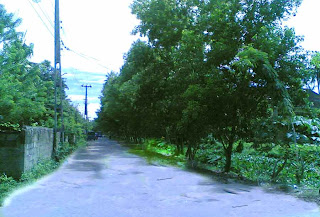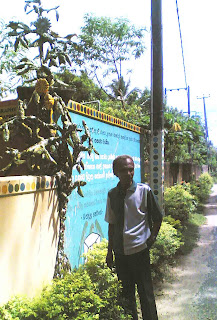The Greatest Treasure we received on Poson Poya Day
June 24, 2010, 9:18 pm by Premasara Epasinghe
island.lk
Buddhism is the first religion in the history of humanity with a universal message of salvation for all mankind. Today, there are about 600 million Buddhists all over the world. The majority of them are in Asia. Buddhism was born in Northern India in 588 B.C. at Saranath, in the vicinity of the snow capped Himalayas. Although, at the beginning, the Buddha, the great teacher, the exalted one, had only five followers; Kondanna, Bhaddhiya, Vappa, Mahanama and Assaji — the ‘Panch-Vaggiya’ bhikkus, Buddhism hereafter made rapid progress. The main reason for this is due to its intrinsic value, reality and the philosophy, which directly appeals to the reasoning mind.
The story how the Buddha Sasana got deeply rooted in Sri Lanka is like a fairy tale. It was fascinating. It all happened on a Poson Pasalosvaka Full Moon Poya Day, with the arrival of Arahat Mahinda Thero, son of the Greatest Emperor of India — Emperor Asoka - during the reign of Devanampiyatissa, the 7th king of Sri Lanka, who ruled for 40 years from 237 to 277 B.C.
307-267 B.C.
The historical facts reveal, from time immemorial that Sri Lanka may have been influenced by the affairs of India. Friendly diplomatic relations existed between India and Sri Lanka. It was in the year 273 B.C., that Asoka, succeeded his father Bindusara to the throne as the next Mauryan Emperor of India (270-230 B.C.). Asoka was ambitious, militant and a war — like monarch. He was keen in extending his kingdom. Therefore, he took uto ‘digvijaya’. He extended his territories by war. He attacked the powerful kingdom of Kalinga. The chronicles record that 100,000 were killed, 150,000 were captured. Many lives were stained and Kalinga was captured after a pitched battle.
Mauryan king Asoka, after this magnificent victory of Kalinga realised the value of life and became a worried man. Mentally he was down. He suffered. He was perturbed at the misery of others, he saw with his own eyes.
One day, as Emperor Asoka, looking out feeling worried, saw at a distance, a saintly little novice — a samanera, walking slowly in perfect composure and dignity. Asoka invited this samanera, Nigrodha, son of Sumana. Nigrodha introduced his teacher, Moggaliputtatissa Thera to the Emperor, later. After the meeting, ‘Chandasoka’, become a virtuous monarch with the ‘Dharmasoka’. Emperor Asoka propagated the Dhamma and in his 17th year, the third "DharmaSangayanawa" (Buddhist Council) was held at Pataliputra, present Patna. All Sri Lankans are indebted to this Great King.
Due to the efforts of this Great Emperor Asoka, Buddhism was established in Sri Lanka. King Devanampiyatissa maintained friendly diplomatic ties with Emperor Asoka. In fact, Asoka gave the greatest gift of all, Buddhism to Sri Lanka by sending his own son Arahat Mahinda on Poson Poya Day. Arahat Mahinda was accompanied by a retinue of six others; Ittiya, Uttiya, Sambala, Baddasala, Sumana and a lay upasaka named Banduka left Jambudvipa – (India), in 236 BE (308 B.C.). They ascended in Missaka Pabbata or Mihintale, eight (8) miles east of Anuradhapura on Poson Day. It marked the beginning of a new era. A new civilization sprang up.
This year’s 2010, Poson Full Moon Poya Day falls today, June 25.
It was the festive season. The Jettamule festival, was in full swing in the month of Poson - June. King Devanampiyatissa, with a retinue of about 40,000 were participating in this festival, went on a hunting expedition to Mihintale Mountain. As the king was chasing a deer around the corner of Mihintale Mountain, he was shocked to see a radiant human being clad in yellow robes, calling him, "Tissa – Tissa" – from the top of Mihintale rock. The king could not believe his eyes, someone calling him Tissa. The king wondered for a moment, at this. He questioned "who are you?" Arahat Mahinda introduced himself, in this manner. He never mentioned that he is the son of Emperor Asoka of India. Arahat Mahinda: uttered thus:-
Samanamayan Maharaja
Dhammarajassa Savaka
Thameva Anukampaya
Jambudipa Idatgatha
(Honourable King, we are the disciples or monks of Buddha – Dharmerya. Through compassion towards you, we came from Jambudipa – India.)
Devanampiyatissa welcomed Arahat Mahinda and the missionaries. Buddhism is not only a religion. It is a philosophy and a way of life. Arahat Mahinda, before expounding the essence of Buddhism, tested the IQ of King Devanampiyatissa, to make sure that the king had the intelligence to grasp what he would be preaching. This brief question and answer discussion can be considered as the "First Intelligence Test" recorded in the Mahavamsa, the great chronicle.
I quote Mahavamsa Chapter XIV, line 16:-
"What is the name of this tree, Oh king?
"This tree is called a mango tree."
"Is there yet another mango tree besides this?"
"And are there yet other mango trees?"
"And are there besides the other mango trees and those trees which are not mango trees, yet other trees?"
"There is this mango tree, Sir"
"Thou has shrewd wit, O ruler of men. Hast thou kinsfolk, o king?"
"There are many sir."
"And are there also some who are not thy kinsfolk?"
"There a more of those than my kin".
Is there anyone besides the kinsfolk and the others?"
"There is myself sir"
Good, thus has a shrewd wit, O ruler of men."
(Mahavamsa XIV, line 16)
After explaining the purpose of his visit, Arahat Mahinda, preached Chullahattipadopama Sutta, to the king and his retinue.
Quote:
Arabhanta Nekkamata – yujjata Buddha sasane
Dhunatha Macchuno senan – natagaranva kunjjaro
Yo immasmin dhamma vinaye
Appamatto vihessati
Pahaya jati sansaran
Dukkassanthan karissati
(Majjima Nikaya)
Start; set forth; observe the doctrine of the blessed one. Destroy the armies of the Mara (Evil one); like an elephant crushing a house made of bamboos. If one observes this doctrine and discipline with diligence, he will overcome birth in samsara and realize the end of suffering).
The Royal patronage extended to Buddhism helped in a big way to spread Buddhism in Sri Lanka. Buddhism was deeply rooted in Sri Lanka during the reign of King Devanampiyatisssa.
There would have different religious belief at this time and the most popular would have been worshipping nature, trees, sun as unseen gods. Sometimes, ten people would have heard about Buddha’s doctrine. As the new religion was state sponsored and as it became the religion of the royalty, many devotees were keen to accept the new philosophy centred round Metta, Karuna and Muditha and Upekkha (love and compassion). All the activities, social, economic, cultural and personal took a more humanitarian view point. Buddhism gained immense Royal Patronage and it helped Buddha Dhamma to be deeply rooted in Sri Lanka. Buddhism became the springboard from which all aspects of personal life and "Art of Living" flourished.
On the second day, Arahat Mahinda was invited to Anuradhapura, the capital, for alms by King Devanampiyatissa. After partaking of alms, Arahat Mahinda delivered a sermon quoting a verse from the Pethavattu.
During Devanampiyatissa’s regime, the first dagabo Thuparama was built. It was the first dagabo constructed in Sri Lanka.
This year’s Poson Full Moon day, today, and is all important, as the Buddhists attend to their religious activities this year without fear and suspicion as peace had dawned in this beautiful island after a long lapse of 31 years. May the Sacred Poson Day, be a blessing for the lasting peace that will bring happiness and entertainment to all of us, irrespective of caste, creed or race. Today, we live as Sri Lankans, under one Parasol.
The advent of Buddhism brought the people of Sri Lanka, other rich dividends too. Refinement in architecture, beautiful statues, monuments, dagobas, formal art and a proud Sinhala literature were woven around Buddhism.
Great Buddhist scholars, poets such as Buddhagosha, Dharmasena, Buddhaputra, Sri Rahula, Wettewe, Gurulugomi, Parakramabahu II Vidusakviti, contributed immensely to Buddhist literature.
Dharmapradeipikava, Amavatura, Butsarana, Dhamsarana, Saddharmaratnavaliya, Pujavaliya, Pansiyapanas Jataka Pota, Kausilumina, Kavyashekeraya, Guttilaya, Budugunalankaraya, Loweda Sangarawa were some of the Budhist books written after the advent of Buddhism.
It is indisputable that Sri Lanka’s structure as an independent peace-loving country had its birth, with the introduction of Theravada Buddhism. The beginning of Sangha Sasana, Bhikkuni Sasana also began with the advent of Buddhism on Poson Full Mon Poya Day. Today, Sri Lanka is the main centre of Theravada Buddhism in the world. The role played by the venerable sangha is enormous. They guided all of us.
Our proud education system was nurtured in the pirivena. On Poson Full Moon Day, we venerate the Buddha Dhamma and especially the Sangha who were mainly responsible in moulding the character of our people. We became civilized and productive citizens and agriculture flourished with the tank and dagaba concept. The message of Arahat Mahinda had the biggest impact on us. Therefore, Poson Full Moon Day is very important to Sri Lankan Buddhists.
Former Prime Minister, the late S. W. R. D. Bandaranaike, once stated; "Buddhism will last as long as the Sun and the Moon last and the human race exists upon Earth, for it is the religion of man of humanity as a whole."
Today, on this Poson day we will dedicate ourselves to practice the doctrine of the Great Teacher, Gauthama Buddha and preserve Theravada Buddhism in our resplendent island.
I wish to conclude this essay quoting a verse written by one one of the greatest Catholic Priests, who contributed immensely in promoting traditional music as well as Sinhala literature, the late Rev Father Marcelline Jayakody:
Yana yana hematena Veherak Sedeeyan
Veherak nethi thenaka Veherak Hadeeyan
Dutu hematenama sil sunwandak meviyan
In yana pani-vidaya nuwanata Deniyan
May there be Dagabas (Pagodas) and Viharas (Temples) everywhere; where there are no Buddhist shrines, may there be Buddhist shrines; let there be virtuous, ones (who possess-sila) everywhere; let this message thereby be transmitted and reach the brain.
Next year, Sri Lanka celebrates the 2600th year of the Buddha’s Enlightement. The above verse will be a fine message for all Buddhists and Sri Lankans.
May the Triple Gem Bless You!






